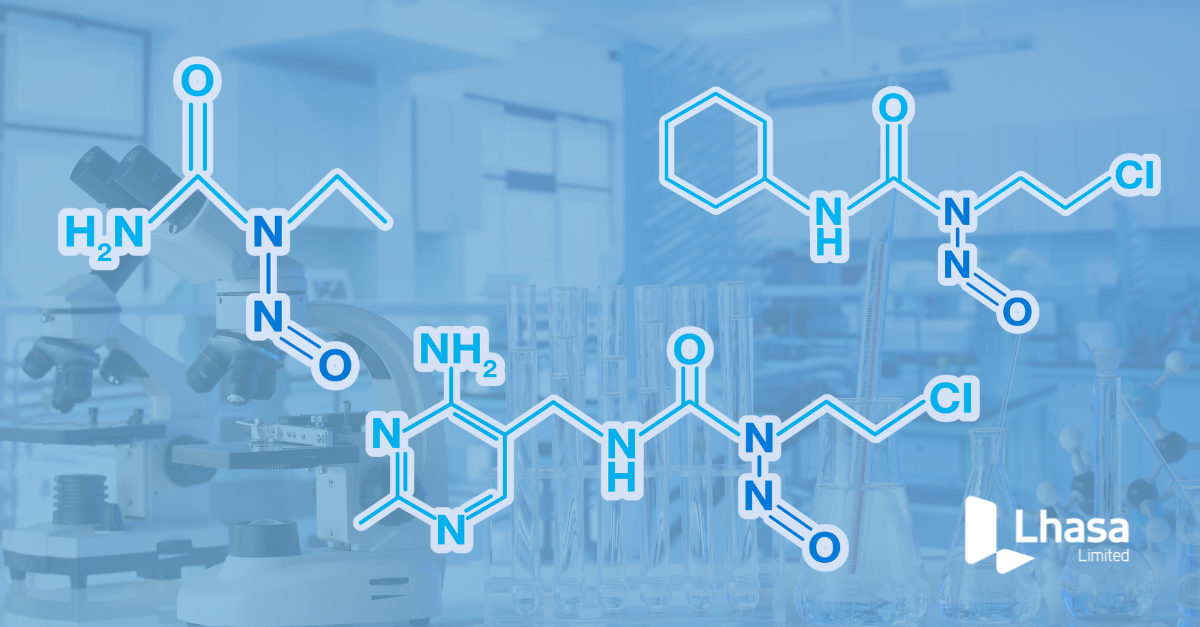In our earlier instalments of the Lhasa blog, we have discussed the latest regulatory insights presented by the U.S. Food and Drug Administration (FDA), the European Medicines Agency (EMA), and Health Canada regarding acceptable intake limits for Nitrosamine Drug Substance-Related Impurities (NDSRIs). Now, our focus zeroes in on the Enhanced Ames Test (EAT) and its role in predicting the mutagenic potential of N-nitrosamine compounds. Join Principal Scientist, Rachael Tennant as she delves into the practical aspects of this testing method and discusses how this compares to the standard Ames test below.
What is the Ames test?
The OECD Test Guideline No. 471 provides an internationally-harmonised recommendation for the conduct of the bacterial reverse mutation test, more commonly known as the Ames test. The assay uses at least five strains of Salmonella typhimurium and Escherichia coli to detect base substitution or frameshift mutations, which revert mutations present in the test strains to restore the functional capability of the bacteria to synthesize an essential amino acid.
How does the test perform for N-nitrosamine compounds?
Using data contained in Vitic and the Lhasa Carcinogenicity database, Lhasa scientists have carried out detailed analyses on the largest known data set for this class of compounds. Initial investigations, as described in our publication ‘Are all nitrosamines concerning? A review of mutagenicity and carcinogenicity data’, demonstrated that the Ames test provides good sensitivity and specificity for N-nitrosamine compounds when compared to a rodent carcinogenicity study, even showing a greater correlation between mutagenicity and carcinogenicity compared to non-nitrosamine compounds.
Resulting from a cross-industry collaboration, our publication ‘Use of the bacterial reverse mutation assay to predict carcinogenicity of N-nitrosamines’ demonstrates that variations in the protocol type used, including strain selection, pre-incubation/plate incorporation, solvent type and S9 metabolic activation type, had little effect on the overall predictive performance of the assay. However, since there is limited data available for certain possible assay variables (e.g. S9 metabolic activation type), and an enormous amount of variation in protocols used in these historical studies, comparison within a specific variable is difficult, therefore some doubts as to the suitability of the assay for this class of compounds remain.
How can the Ames test currently be used for N-nitrosamines?
In order to address sensitivity concerns surrounding the Ames test for this class, a new guidance has been published by regulatory authorities which recommends enhanced testing conditions for NDSRIs that are negative in the standard OECD-compliant assay. A negative result in the EAT may be used to support control of an NDSRI at a higher limit (1.5 µg/day as per EMA and Health Canada guidance). Here’s how the EAT compares to a standard Ames test:
| Condition | Standard OECD Ames test | Enhanced Ames Testa |
| Tester strains | S. typhimurium
E. coli
|
S. typhimurium
E. coli
|
| Protocol | Preincubation (20 mins incubation time) or plate incorporation. | Preincubation (30 mins incubation time). |
| Metabolic activation | 5-30% S9 prepared from the livers of rodents treated with enzyme-inducing agents such as Aroclor 1254 or a combination of phenobarbitone and ß- naphthoflavone, and in the absence of S9. | 30% rat liver S9, 30% hamster liver S9, as well as in the absence of S9. S9 should be prepared from rodents treated with inducers of cytochrome P450 enzymes (e.g., a combination of phenobarbital and β-naphthoflavone). |
| Solvent/Negative control | Water/organic solvent. | Water/organic solvent (the lowest possible volume should be included in the pre-incubation mixture with justification to indicate that the volume of solvent does not interfere with metabolic activation of the N-nitrosamine). |
| Positive control | Concurrent strain-specific positive controls. | In addition to concurrent strain-specific positive controls, two N-nitrosamines that are known to be mutagenic in the presence of S9 should be included, the choice of which should be justified based on the anticipated metabolism of the N-nitrosamine and the cytochrome P450 enzymes most likely involved. |
a EMA (Annex 3), Health Canada (Annex 3), FDA (Recommended Safety Testing Methods for NDSRIs)
What is the future of the Ames test for N-nitrosamines?
Confidence in the Ames test protocol used for the testing of N-nitrosamine compounds is essential to determine genotoxic risk effectively and efficiently, while reducing the need for costly and time-intensive in vivo studies.
It is important to understand the impact that protocol variability may have, and evaluation of Ames assay test conditions for N-nitrosamines remains ongoing. Regulatory agencies are working closely alongside industry stakeholders to identify the most robust testing conditions, and regulatory guidance will be updated as warranted.
Our recent publication, ‘A deep dive into historical Ames study data for N-nitrosamine compounds’, scrutinises the vast amount of individual study data within Vitic, allowing us to highlight limitations of historical studies that should be addressed before a standard Ames test protocol for N-nitrosamines can be recommended. By identifying where gaps in the knowledge lie, we can work together to refine and optimise assay conditions to ensure a high sensitivity is achieved without compromising on specificity.
Find out more about our tools which we offer for in silico mutagenicity assessment – Derek Nexus, Sarah Nexus and Vitic on our solutions page.
Last Updated on October 17, 2024 by lhasalimited



